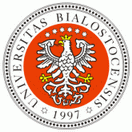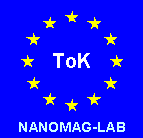Sponsors:





|
|
Organized by
the Institute of Experimental Physics, University of Bialystok
Roman Puzniak
Institute of Physics, Polish Academy of Sciences, Aleja Lotnikow 32/46, PL 02-668 Warszawa, Poland
Peculiar features of two-gap superconductivity in MgB2 - magnetic studies
-
MgB2 is the first superconductor in which a two-band two-gap nature of superconductivity is clearly observed. Several anomalous properties of this compound originating from the existence of two separate sheets of the Fermi surface involved in superconductivity: first one is quasi 2D (s band) and a second one is quasi 3D (p band). This electronic structure and strong electron-phonon coupling, predominantly on the s sheet, lead to the high critical temperature Tc of 39 K, and to a pronounced temperature and field dependent anisotropy of electronic properties, particularly in the superconducting state. Relatively high Tc of MgB2 makes this compound interesting from the point of view of applications. However, potential for applications is limited by the comparatively low upper-critical field, i.e., Hc2(0)~3 T for HIIc.
Chemical substitutions influence the basic properties of MgB2 and help to clarify a number of issues related to the mechanism which is responsible for superconductivity in this particular compound. In some cases they also make it suitable for practical applications by increasing Hc2(T). I will discuss the results of magnetic measurements performed on single crystals with partial substitution of either Mg or B. Substitutions of Al for Mg and C for B lead to an increase of scattering within both p and s bands, however, with different rates for both substituents. Therefore, different changes of Hc2, and its anisotropy, gHc2, for Mg1-xAlxB2 and MgB2-xCx are observed. Single crystals of Mg1-xAlxB2 show a moderate decrease of Tc, for the samples with small x and, simultaneously, significant reduction of Hc2 and its anisotropy at lower temperatures, as compared to the value for unsubstituted crystals. The temperature dependence of the anisotropy is less pronounced. Single crystals of MgB2-xCx exhibit only slight reduction of Tc with substitution and, moreover, a significant increase of Hc2 for an applied field oriented both parallel, Hc2IIab, and perpendicular, Hc2IIc, to the ab-plane. For the single crystal with x = 0.13, Hc2IIc(0) ~ 8.5 T is more than twice as large as that for an unsubstituted compound. The anisotropy of Hc2 decreases from 6 (x = 0) to about 4 (x = 0.13) at low temperatures. Hole doping with Li decreases Tc, but in much slower rate than electron doping with C and Al. For MgB2 crystals with simultaneously substituted Li for Mg and C for B, Tc decreases more rapidly than in the case when only C is substituted. Substitution of magnetic Mn for Mg strongly suppresses Tc and Hc2 due to the magnetic pair breaking. However, this is not the case for the substitution of Fe for Mg, at least for low Fe concentration.
This work was supported by the Polish State Committee for Scientific Research under a research Project for the years 2004-2007 (1 P03B 037 27).
|
|
|